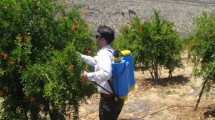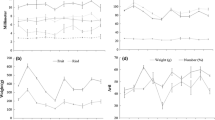Abstract
Pomegranate (Punica granatum L.) fruits are used mainly by the juice industry, for which seeds are a by-product to be disposed of, though they could potentially be a source of bioactive compounds. In this work, germination (total germination percentage, G; mean germination time, MGT; time to reach 80% of germination, TG80; seedling shoot length, fresh weight and dry matter), and nutritional value (total phenolics, TP; total flavonoids, TF; total non-tannins, TNT; antioxidant activities) of pomegranate seeds and sprouts were determined on four commercial pomegranate cultivars (Akko, Dente di Cavallo, Mollar de Elche and Wonderful). Seeds were removed from ripe fruits and incubated in plastic trays containing sterile cotton wetted with distilled water. Sprout shoots were harvested when they reached the complete cotyledon expansion, i.e., the ready-to-eat stage. Akko showed the best germination performance (G = 98%; MGT = 14 days after sowing, DAS; TG80 = 16 DAS), followed by Mollar de Elche. Sprouting dramatically increased TP, TF, TNT and antioxidant activity in all genotypes, with the highest values recorded in Mollar de Elche and Dente di Cavallo. Overall, based on germination performance, Akko and Mollar de Elche would be the best cultivars for sprouting. Sprouting pomegranate seeds appears to be a suitable way of utilizing by-products of the juice industry to obtain bioactive compounds.



Similar content being viewed by others
Abbreviations
- ABTS:
-
2,2′-azino-bis(3-ethylbenzothiazoline-6-sulfonic acid) sodium salt
- DAS:
-
Days after sowing
- DPPH:
-
2,2-diphenyl-1-picrylhydrazyl
- DW:
-
Dry weight
- FRAP:
-
Ferric reducing antioxidant power
- G:
-
Germination percentage
- GAE:
-
Gallic acid equivalent
- MGT:
-
Mean germination time
- PUFA:
-
Polyunsaturated fatty acids
- TE:
-
Trolox equivalent
- TF:
-
Total flavonoids
- TG80:
-
Time to reach 80% germination
- TNT:
-
Total non-tannins
- TP:
-
Total phenolics
References
Viuda-Martos M, Fernández-López J, Pérez-Álvarez JA (2010) Pomegranate and its many functional components as related to human health: a review. Compr Rev Food Sci F 9:635–654
Moazzen H, Alizadeh M (2017) Effects of pomegranate juice on cardiovascular risk factors in patients with metabolic syndrome: a double-blinded randomized crossover control trial. Plant Foods Hum Nutr 72:126–133
Jing P, Ye T, Shi H, Sheng Y, Slavin M, Gao B, Liu L, LL Y (2012) Antioxidant properties and phytochemical composition of China-grown pomegranate seeds. Food Chem 132:1457–1464
Pande G, Akoh CC (2009) Antioxidant capacity and lipid characterization of six Georgia-grown pomegranate cultivars. J Agric Food Chem 57:9427–9436
Bonzanini F, Bruni R, Palla G, Serlataite N, Caligiani A (2009) Identification and distribution of lignans in Punica granatum L., fruit endocarp, pulp, seeds, wood knots and commercial juices by GC-MS. Food Chem 117:745–749
Dillard CJ, German JB (2000) Review. Phytochemicals: nutraceuticals and human health. J Sci Food Agric 80:1744–1756
Guo S, Deng Q, Xiao J, Xie B, Sun Z (2007) Evaluation of antioxidant activity and preventing DNA damage effect of pomegranate extracts by chemiluminescence method. J Agric Food Chem 55:3134–3140
Lansky EP, Newman RA (2007) Punica granatum (pomegranate) and its potential for prevention and treatment of inflammation and cancer. J Ethnopharmacol 109:177–206
MacFarlin BK, Strohacker KA, Kueht ML (2009) Pomegranate seed oil consumption during a period of high-fat feeding reduces weight gain and reduces type 2 diabetes risk in CD-1 mice. Br J Nutr 102:54–59
Elbandy MA, Ashoush IS (2012) Phytochemicals in pomegranate seeds and their effects as hypolipidemic agent in hypercholesterolemic rats. World J Dairy Food Sci 7:85–92
Caligiani A, Bonzanini F, Palla G, Cirlini M, Bruni R (2010) Characterization of a potential nutraceutical ingredient: pomegranate (Punica granatum L.) seed oil, unsaponifiable fraction. Plant Foods Hum Nutr 65:277–283
He L, Xu H, Liu X, He W, Yuan F, Hou Z, Gao Y (2011) Identification of phenolic compounds from pomegranate (Punica granatum L.) seed residues and investigation into their antioxidant capacities by HPLC-ABTS+ assay. Food Res Int 44:1161–1167
Vinokur Y, Rodov V, Horev B, Goldman G, Aharoni N (2013) Pomegranate sprouts, preparations derived therefrom and compositions comprising same. US Patent No. 8,501,257 B2, 6 August 2013
Màrton M, Zs M, Zs C-K, Csapó J (2010) The role of sprouts in human nutrition. A review. Acta Universitatis Sapientiae Alimentaria 3:81–117
Benincasa P, Galieni A, Manetta AC, Pace R, Guiducci M, Pisante M, Stagnari F (2015) Phenolic compounds in grains, sprouts and wheatgrass of hulled and non-hulled wheat species. J Sci Food Agric 95:1795–1803
Rawat JMS, Tomar YK, Rawat V (2010) Effect of stratification on seed germination and seedling performance of wild pomegranate. J Am Sci 6:97–99
Olmez Z, Temel F, Gokturk A, Yahyaoglu Z (2007) Effects of sulphuric acid and cold stratification pretreatments on germination of pomegranate (Punica granatum L.) seeds. Asian J Plant Sci 6:427–430
Kalaycioğlu Z, Erim FD (2017) Total phenolic contents, antioxidant activities, and bioactive ingredients of juices from pomegranate cultivar worldwide. Food Chem 221:496–507
Ellis RA, Roberts EH (1981) The quantification of ageing and survival in orthodox seeds. Seed Sci Technol 9:373–409
AOAC (1980) Official methods of analysis - vitamins and other nutrients. AOAC, Inc., Arlington, USA, pp 1058–1060
Yasoubi P, Barzegar M, Sahari MA, Azizi MH (2007) Total phenolic contents and antioxidant activity of pomegranate (Punica granatum L.) peel extracts. J Agric Sci Technol 9:35–42
Singleton VL, Rossi JA (1965) Colorimetry of total phenolics with posphomolybdic-phosphotungstic acid reagents. Am J Enol Vitic 16:144–158
Floridi S, Montanari L, Marconi O, Fantozzi P (2003) Determination of free phenolic acids in wort and beer by coulometric array detection. J Agric Food Chem 51:1548–1554
Thaipong K, Boonprakob U, Crosby K, Cisneros-Zevallos L, Byrne DH (2006) Comparisons of ABTS, DPPH, FRAP and ORAC assays for estimating antioxidant activity from guava fruit extracts. J Food Compos Anal 19:669–675
R Core Team (2014) R: a language and environment for statistical computing. R Foundation for Statistical Computing, Vienna http://www.R-project.org/
Shalimu D, Li K, Baskin CC, Baskin JM, Liu YJ (2015) Seed germination biology of four pomegranate (Punica granatum) cultivars from Xinjiang, China. Hortscience 50:826–829
Elfalleh W, Hannachi H, Tlili N, Nasri N, Ferchichi A (2012) Total phenolic contents and antioxidant activities of pomegranate peel, seed, leaf and flower. J Med Plant Res 6:4724–1730
Basiri S (2015) Evaluation of antioxidant and antiradical properties of pomegranate (Punica granatum L.) seed and defatted seed extracts. J Food Sci Technol 52:1117–1123
Orak HH, Yagar H, Isbilir S (2012) Comparison of antioxidant activities of juice, peel, and seed of pomegranate (Punica granatum L.) and inter-relationships with total phenolic, tannin, anthocyanin, and flavonoid content. Food Sci Biotechnol 21:373–387
Hümmer W, Schreier P (2008) Analysis of proanthocyanidins. Mol Nutr Food Res 52:1381–1393
Schofield P, Mbugua DM, Pell AN (2001) Analysis of condensed tannins: a review. Anim Feed Sci Technol 91:21–40
Serrano J, Puupponen-Pimiă R, Dauer A, Aura AM, Saura-Calixto F (2009) Tannins: current knowledge of food sources, intake, biovailability and biological effects. Mol Nutr Food Res 53:310–329
Acknowledgements
We gratefully acknowledge Mr. Silvano Locchi for technical assistance in the seed lab and Mr. Giacomo Linoci for providing the pomegranate fruits used in this study. We thank Darcy Gordon (PhD) for language editing and for critical review of the manuscript.
Author information
Authors and Affiliations
Corresponding author
Ethics declarations
Conflict of Interest
Authors declare no conflict of interest.
Rights and permissions
About this article
Cite this article
Falcinelli, B., Marconi, O., Maranghi, S. et al. Effect of Genotype on the Sprouting of Pomegranate (Punica granatum L.) Seeds as a Source of Phenolic Compounds from Juice Industry by-Products. Plant Foods Hum Nutr 72, 432–438 (2017). https://doi.org/10.1007/s11130-017-0645-y
Published:
Issue Date:
DOI: https://doi.org/10.1007/s11130-017-0645-y




